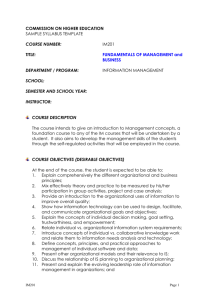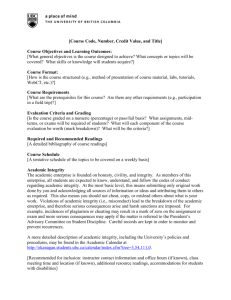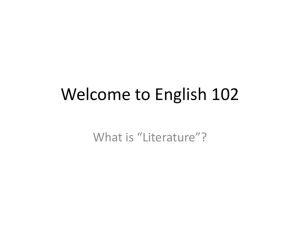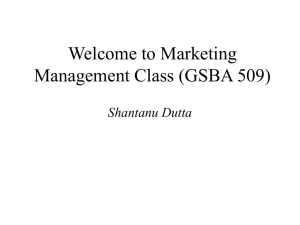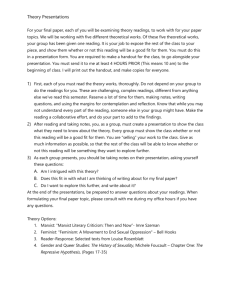C W A
advertisement
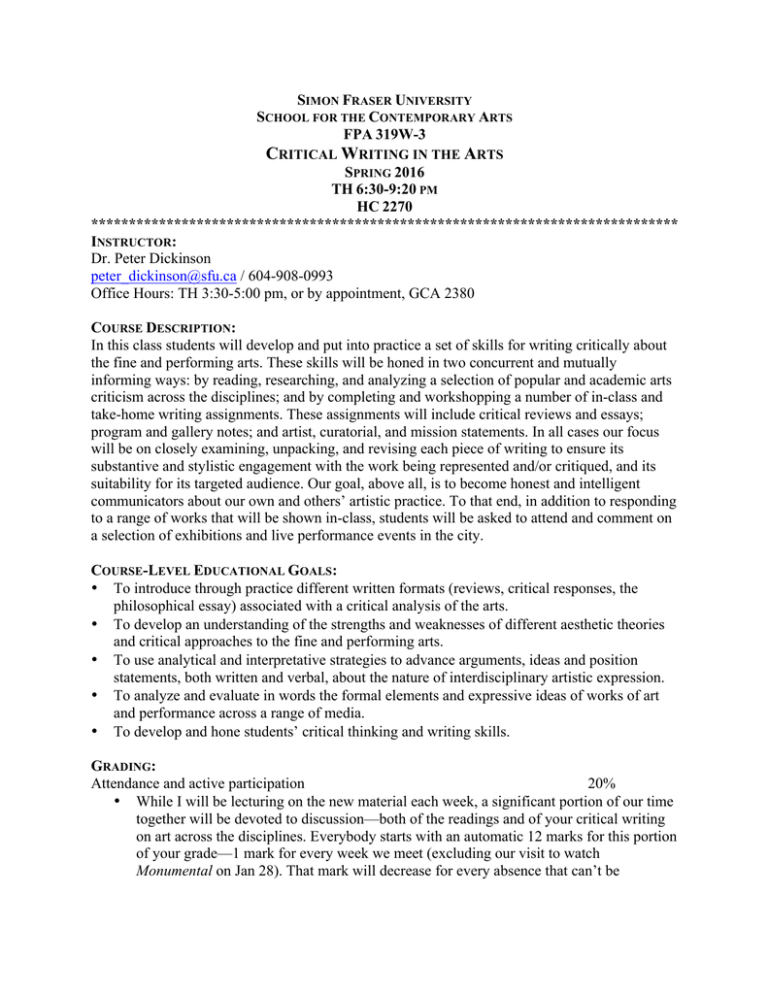
SIMON FRASER UNIVERSITY SCHOOL FOR THE CONTEMPORARY ARTS FPA 319W-3 CRITICAL WRITING IN THE ARTS SPRING 2016 TH 6:30-9:20 PM HC 2270 ****************************************************************************** INSTRUCTOR: Dr. Peter Dickinson peter_dickinson@sfu.ca / 604-908-0993 Office Hours: TH 3:30-5:00 pm, or by appointment, GCA 2380 COURSE DESCRIPTION: In this class students will develop and put into practice a set of skills for writing critically about the fine and performing arts. These skills will be honed in two concurrent and mutually informing ways: by reading, researching, and analyzing a selection of popular and academic arts criticism across the disciplines; and by completing and workshopping a number of in-class and take-home writing assignments. These assignments will include critical reviews and essays; program and gallery notes; and artist, curatorial, and mission statements. In all cases our focus will be on closely examining, unpacking, and revising each piece of writing to ensure its substantive and stylistic engagement with the work being represented and/or critiqued, and its suitability for its targeted audience. Our goal, above all, is to become honest and intelligent communicators about our own and others’ artistic practice. To that end, in addition to responding to a range of works that will be shown in-class, students will be asked to attend and comment on a selection of exhibitions and live performance events in the city. COURSE-LEVEL EDUCATIONAL GOALS: • To introduce through practice different written formats (reviews, critical responses, the philosophical essay) associated with a critical analysis of the arts. • To develop an understanding of the strengths and weaknesses of different aesthetic theories and critical approaches to the fine and performing arts. • To use analytical and interpretative strategies to advance arguments, ideas and position statements, both written and verbal, about the nature of interdisciplinary artistic expression. • To analyze and evaluate in words the formal elements and expressive ideas of works of art and performance across a range of media. • To develop and hone students’ critical thinking and writing skills. GRADING: Attendance and active participation 20% • While I will be lecturing on the new material each week, a significant portion of our time together will be devoted to discussion—both of the readings and of your critical writing on art across the disciplines. Everybody starts with an automatic 12 marks for this portion of your grade—1 mark for every week we meet (excluding our visit to watch Monumental on Jan 28). That mark will decrease for every absence that can’t be medically documented. I reserve a discretionary 8 marks to reward you for active and engaged participation in our weekly class discussions and in-class activities Blog posts and weekly short writing assignments 20% • As this is a writing-intensive course, a portion of every class will be given over to articulating in prose your thoughts about different aesthetic questions and the critical analysis of the fine and performing arts. These will be low-stakes writing prompts based on questions posed by me and/or material we will review together. In addition, based on your group assignments for your final presentations, you will be responsible for making two individual blog posts over the course of the semester. These will be based on questions I will pose in connection with our weekly readings. Two additional blog posts are required relating to the regular arts reporting “picks of the week” we will collectively establish. Specific instructions about both sets of blog posts can be found in a separate document posted to Canvas. Critical review 15% • See the instructions posted to Canvas. Precedent analysis and artist/critic’s statement 15% • See the instructions posted to Canvas. Critical essay and class presentation 30% • See the instructions posted to Canvas. REQUIRED TEXTS: Unless otherwise indicated via online hyperlinks included in the weekly syllabus below, all readings for this course have been posted as pdf documents to Canvas. To access Canvas, go to https://canvas.sfu.ca and enter your SFU computing id and password. From your dropdown list of courses, click FPA 319W; this will take you to our course homepage. MATERIAL LIST: Though not required, it would be helpful if students who have access to their own laptop computers or tablets (and adapters, if needed) could bring them to each class in order to help facilitate the sharing of in-class writing exercises. PREREQUISITE: 60 credits, including at least 6 credits of FPA history/theory courses. WEEKLY SYLLABUS: 1. Jan 7 Introduction Readings: - Oscar Wilde, from “The Critic as Artist” In-class: - Introduction to the course - Discussion of Wilde reading: a dialogue on the arts, arts criticism, and artist-critics - Screening of and short written response to excerpt from Pina - Assigning of reading/blogging/editing/presentation groups 2 For next week: - Collect three program/curatorial notes or performance/exhibition synopses from three different disciplines that you deem exemplary or especially compelling - Group 1: Blog post on assigned readings (see below) - Group 2: Blog post on arts reporting pick of the week 2. Jan 14 The Function of Criticism: Describing/Interpreting/Analyzing/Judging Readings: - Susan Sontag, “Against Interpretation” - Deborah Jowitt, “Beyond Description: Writing Beneath the Surface” - Roger Copeland, “Between Description and Deconstruction” - Richard Brody, “Susan Sontag on Movies” - Josette Féral, “’The Artwork Judges Them’” In-class: - Picks of the week - Discussion of assigned readings - Presentation and discussion of collected program notes and performance/exhibition synopses - Overview of critical writing fundamentals: style, sentence mechanics, and grammar For next week: - Capsule review (100 words) of Dana Claxton show at Audain Gallery, SFU Woodward’s - Collect three short- to medium-length arts reviews from three different disciplines that you deem exemplary or especially compelling - Group 3: Blog post on assigned readings (see below) - Group 4: Blog post on arts reporting pick of the week 3. Jan 21 The Role of the Critic: Response and Responsibility Readings: - Joan Acocella, “What Critics Do” and “What’s Good about Bad Reviews” - Arlene Croce, “Discussing the Undiscussable” - Irit Rogoff, “From Criticism to Critique to Criticality” - Daniel Mendelsohn, “A Critic’s Manifesto” - Andy Horowitz, “Re-Framing the Critic for the 21st Century: Dramaturgy, Advocacy and Engagement,” http://www.culturebot.org/2012/09/13258/re-framing-the-critic-for-the-21stcentury-dramaturgy-advocacy-and-engagement/ In-class: - Picks of the week - Discussion of assigned readings - Presentation and discussion of collected reviews - Presentation and discussion of capsule reviews - Drafting of the FPA 319W Critics’ Manifesto - Assigning of peer editors 3 For two weeks: - Read all of the assigned sample reviews for next week, and be prepared to discuss their particular strengths - Read Robert Christgau’s “Writing about Music is Writing First” and at least two other of the “Writing About” readings (though you are, of course, encouraged to read them all if you have time): be prepared to summarize their advice/best practices - Group 5: Blog post on assigned readings (see below) - Group 6: Blog post on arts reporting pick of the week - Expand on your draft capsule review of either the Dana Claxton exhibition or the Monumental performance (see below) as the basis for a 500-word critical review - Send an electronic draft of your review to your editor by noon on Wednesday, February 3rd 4. Jan 28 Monumental Performance at Queen Elizabeth Theatre - Post a 100-word capsule review of the Monumental show to the Wordpress blog for the course by the end of the day on January 29th 5. Feb 4 Review Writing: Within and Across the Disciplines Readings: - Sylvan Barnet, from A Short Guide to Writing about Art - Robert Christgau, “Writing about Music is Writing First” - Timothy Corrigan, from A Short Guide to Writing about Film - Suzanne Hudson, from Writing about Theatre and Drama - Wendy Oliver, from Writing about Dance - Sample reviews by: Deborah Jowitt; Pauline Kael; and Peter Schjeldahl In-class: - Picks of the week - Presentation and discussion of sample reviews by Jowitt, Kael and Schjeldahl - Discussion of disciplinary fundamentals readings - Review editing workshop and commentary For Monday, February 8th: - Revise 500-word review for final submission and send an electronic copy as a Word attachment to my email address (peter_dickinson@sfu.ca) by noon on February 8th For two weeks: - Complete all the readings for next week and be prepared to define the tastes of your artistic audience/public - Bring in an example of one “low”/pop cultural product (e.g. a song by Rihanna) whose artistic merits you are prepared to defend and one “high” cultural product (e.g. an opera by Verdi) whose accepted greatness you wish to challenge (N.B.: it would be helpful if these can be in a form easily shared with the class—i.e., shown/played on a computer, etc.) - Group 2: Blog post on assigned readings (see below) - Group 1: Blog post on arts reporting pick of the week 4 Feb 11 READING BREAK: NO CLASS 6. Feb 18 Art Publics 1: A Question of “Taste” Readings: - David Hume, “Of the Standard of Taste” - Carl Wilson, from Let’s Talk about Love (chs. 7 and 8 especially) - Ted Cohen, “High and Low Thinking about High and Low Art” - Leo Steinberg, “Contemporary Art and the Plight of Its Public” In-class: - Picks of the week - Discussion of readings and our art publics - Presentation, defense, and written response to products of our artistic tastes For next week: - Read the interviews with Mark Morris, Martin Scorsese and Jeff Wall: for each artist, identify at least one influence they cite from within their own discipline and one influence they cite from outside their discipline - Draft a short (300 word) precedent analysis as a way of reflecting on the artists and/or artistic movements/innovations/practices that have influenced your own work - Bring a draft of your precedent analysis to class, along with any additional visual or other aids (slides, clips, etc.) you wish, and be prepared to present your work to the class 7. Feb 25 Art Publics 2: A Question of “Precedent” Readings: - Interviews with Mark Morris, Martin Scorsese, and Jeff Wall In-class: - Discussion of the readings - Presentation and peer review of precedent analyses For next week: - Revise your precedent analysis - Read the artist statements excerpted from Stiles and Selz - Collect three exemplary artist statements from three different disciplines and be prepared to discuss their virtues - Draft your own 300-word artist/critic’s statement and send an electronic copy to your editor by noon on Wednesday, March 2nd - Do research on project funding grants, professional development workshops, internships or residencies to which you might apply with a version of your artist statement and precedent analysis; bring this information to class 5 8. March 3 Artist/Critic’s Statements Readings: - Artist statements by Joseph Beuys, Dick Higgins, Keith Haring, and Cindy Sherman (from Stiles and Selz, eds., Theories and Documents of Contemporary Art) In-class: - Picks of the week - Discussion of posted and collected artist statements - Artist/critic’s statement editing workshop; review of precedent analyses; pitching of possible grant, professional development, or internship/residency proposals to which you might apply, and how you might tailor your artist statement and precedent analysis accordingly For next week: - Revise your precedent analysis and artist/critic’s statement for final submission; include details on your hypothetical pitch (see above) - Complete all of the readings and be prepared to discuss which you found most compelling - Group 4: Blog post on assigned readings (see below) - Group 3: Blog post on arts reporting pick of the week 9. Mar 10 Critical Essays 1: On Artists Readings: - Joan Acocella, “Second Act” - Asawin Suebsaeng, “This Is Why Michael Bay Gets to Keep On Making Movies,” http://www.motherjones.com/media/2013/05/michael-bay-interview-pain-and-gain - Peggy Phelan, “Marina Abramović: Witnessing Shadows” In-class: - Picks of the week - Discussion of the readings - Overview of research fundamentals: background reading; library and online searches; interviewing techniques; etc. - Group presentation keywords check-in and brainstorming session (see separate assignment instructions) For next week: - Complete all of the readings and be prepared to discuss which you found most compelling - Group 6: Blog post on assigned readings (see below) - Group 5: Blog post on arts reporting pick of the week - Write a 100-word abstract/proposal for a critical essay on an artist or art movement/practice/etc. that connects to your group’s chosen keywords in some way (see separate assignment instructions) 6 10. Mar 17 Critical Essays 2: On Art Movements/Practices/Controversies/Scenes/Trends Readings: - Ann Daly, “The Balanchine Woman” - Deirdre Kelly, “Striving and Starving for Attention” - J. Hoberman, “21st Century Cinema” - Steven Shaviro, “Post-Continuity,” http://www.shaviro.com/Blog/?p=1034 - Caroline Jones, “Staged Presence” - Carrie Lambert-Beatty, “Against Performance Art” In-class: - Picks of the week - Discussion of the readings - Discussion of critical essay proposals and criteria for final assignment - Overview of research fundamentals, continued: who is your audience and how to begin writing? - Group presentation keywords check-in and brainstorming session (see separate assignment instructions) For next week: - Begin writing your 1200-word critical essay and bring a draft of it to class to share with your peer review editor 11. Mar 24 Critical Essay Editing Workshop In-class: - Critical essay editing workshop and commentary - Group presentation keywords check-in, brainstorming session, and drafting of collective curatorial statement (see separate assignment instructions) 12. Mar 31 Presentations For next week: - Revise your critical essay for final submission 13. April 7 Presentations NOTES 1. The main goal of this course is to improve your craft as writers, with specific application to the fine and performing arts. And yet while everyone will receive both one-on-one peer editorial support for their main writing projects, and while additionally each student will receive collective scrutiny on their writing at least once in-class, there are still ways for you to do extra individual work on the basics of style and grammar. To that end, see the University of Toronto’s online “Style and Editing” advice at http://www.writing.utoronto.ca/advice/style-and-editing. See, as well, the following arts-related writing/subject guides from Harvard: i) http://isites.harvard.edu/fs/docs/icb.topic649702.files/Writing_About_Music.pdf; ii) 7 http://isites.harvard.edu/fs/docs/icb.topic649702.files/Peformance_Studies.pdf; iii) http://isites.harvard.edu/fs/docs/icb.topic649702.files/Writing%20about%20Art_final%20web.pd f. 2. No late assignments will be accepted without a documented medical excuse. Plagiarism or academic dishonesty of any kind will not be tolerated in this course. Students are responsible for knowing SFU’s policies on these matters. Consult the following website for more information: http://www.sfu.ca/content/dam/sfu/policies/files/students/S10.01.pdf. For all submitted writing, I request that you double-space, use 12-point font, and leave one-inch margins. When citing from secondary sources in your writing (particularly your critical essays), please follow MLA guidelines. A condensed MLA Citation Guide prepared by SFU Library is available at http://www.lib.sfu.ca/system/files/28303/MLA.pdf. All assignments will be given letter grades and will be assessed according to the following standards: Grade A+ A A- % Range 96 -100 90 - 95 85 - 89 B+ B B- 80 - 84 75 - 79 70 - 74 C+ C C- 65 - 69 60 - 64 55 - 59 D 50 - 54 F 0 - 49 Evaluation Criteria Outstanding performance. Represents work of exceptional quality. Content, organization, expression, and style all of a high standard. Comprehension of the subject and use of existing research and literature has been abundantly demonstrated. Uses sound critical thinking, has innovative ideas on the subject, argues the topic convincingly and presents sound evidence to back up claims. Shows personal engagement with the topic. Good performance. Represents work of above average quality with no major weaknesses in argumentation or expression. Writing is clear and explicit and topic coverage and comprehension are more than adequate, although occasional lapses in reasoning or style may be present. Shows some degree of independent critical thinking and personal involvement in the work. Good use of existing knowledge on the subject. Satisfactory performance. Represents work of competent quality. Shows some comprehension of the subject, but has more frequent weaknesses and/or problems in content, style, argumentation, expression, or organization. Minimal critical awareness or personal involvement in the work has been demonstrated. Only adequate use of the literature and/or addressing of the topic. Marginal performance. Represents work of a barely adequate quality. Serious flaws in content, organization, and/or style. Grammatical errors tend to be frequent and often reflect a lack of basic linguistic competency. Argument is mostly off-topic and/or evidence is contradictory or poorly marshaled. Poor comprehension of the subject and engagement with existing research and literature. Minimal critical involvement in paper. Failing performance. Represents work of substandard quality. Either clearly does not respond to the assigned topic or contains errors in grammar, organization, and expression that do not meet the minimum acceptable academic standards. Work that has been plagiarized should automatically receive a failing grade. 8
